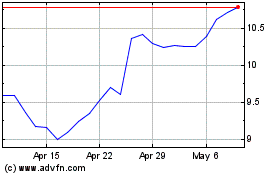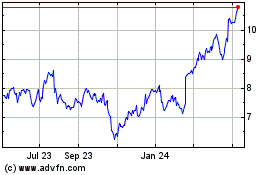European Banks Are Hit Again Despite Central Bank Intervention
March 16 2020 - 2:44PM
Dow Jones News
By Margot Patrick and Patricia Kowsmann
European bank shares slid and prices on their riskiest debt
touched new lows as the region braced for a prolonged economic
slowdown as a result of the spreading coronavirus.
Investors are trying to calculate banks' exposure to hard-hit
airline, retail and oil giants -- as well as hundreds of thousands
of small businesses across the region -- while also worrying about
the longer-term impact for lenders' profitability and capital
positions. Central banks and governments are providing liquidity,
easing capital buffers and laying out debt-relief measures but so
far the steps have done little to halt the slide in stock prices
for the region's largest banks.
Shares in Barclays PLC fell 13% and Credit Suisse Group AG was
off 9% Monday, reflecting concern about their corporate
counterparties, while UniCredit SpA slumped 12% as the death toll
rose in Italy. The main European banks stock index fell 8.4%,
bringing its decline this year to 42%.
The price of Unicredit's perpetual bonds, callable from June
2023, fell to EUR80 ($89.30), from around EUR113 in mid-February,
indicating investors see a significant risk its capital could be
depleted enough to trigger the bonds' conversion to equity. The
price on a similar bond from Deutsche Bank AG ended the day Monday
at EUR65, down EUR9 from Friday.
Danske Bank AS, Denmark's largest lender by assets, scrapped its
profit guidance for the year and said it expects loan impairment
charges to rise from the economic disruption. It said its capital
and liquidity "remain strong with significant buffers well above
the regulatory requirements."
Italy's government on Monday approved a financing package to
help businesses and households ride out the outbreak, as other
countries including Spain, France and Germany introduced tougher
measures against travel and socializing to curb the virus's spread.
The European Commission is proposing a 30-day ban for nonessential
travel into the European Union.
European banks have raised capital, cleaned up their loan books
and undergone an array of stress tests over recent years to prepare
them for market and economic shocks, after many needed bailing out
in the previous financial crisis of 2008.
On Monday, S&P Global Ratings credit analyst Bernd Ackermann
said banks' "saving grace" is that their balance sheets have rarely
been stronger, and the core capitalization is at record highs.
According to data from the European Banking Authority, capital
ratios were 14.41% last year, from around 8% before the 2008
financial crisis.
"The vast majority of European financial institutions we rate
have solid credit profiles and we believe are well placed to
withstand the difficult period to come," Mr. Ackermann said.
To help ease stresses, the European Central Bank on Thursday
offered up to EUR2.3 trillion in cheap borrowing for eurozone
banks, and freed up some EUR550 billion in capital by temporarily
lowering requirements, according to estimates by Jérôme Legras,
head of research at Axiom Alternative Investments.
But risks abound.
Low profitability at banks, for instance, spells potential
capital trouble. Deutsche Bank AG and German peer Commerzbank AG
are particularly vulnerable because the sector has struggled to
make money in an overcrowded German market even during the economic
boom. Loan losses eat capital, and new accounting rules means banks
have to anticipate potential losses in real time and based on
macroeconomic conditions.
"While it is hard to fathom the depth of the oncoming
asset-quality cycle, it is already clear at this point that the
profitability of many banks is inadequate to manage through a
prolonged economic crisis that results in heightened provisioning
needs," Marco Troiano, deputy head of the banks team at rating
agency Scope Ratings, said.
Another potentially trouble spot lies in the endless loop
between banks and sovereign risks in Europe. After the financial
crisis in 2008, governments had to rescue banks, which
overstretched their own finances. That led to the sovereign-debt
crisis in 2010, which hurt banks even more.
Tom Kinmonth, a fixed income strategist at Dutch lender ABN AMRO
Bank NV, said the key thing for banks is the length of the
disruption.
"If things get better over the next few weeks, things will be OK
on the banking side. If they last longer, then it's a problem," he
said.
"The banks that make it through will have a big upside after all
this," Mr. Kinmonth said.
(END) Dow Jones Newswires
March 16, 2020 14:29 ET (18:29 GMT)
Copyright (c) 2020 Dow Jones & Company, Inc.
Barclays (NYSE:BCS)
Historical Stock Chart
From Mar 2024 to Apr 2024

Barclays (NYSE:BCS)
Historical Stock Chart
From Apr 2023 to Apr 2024
